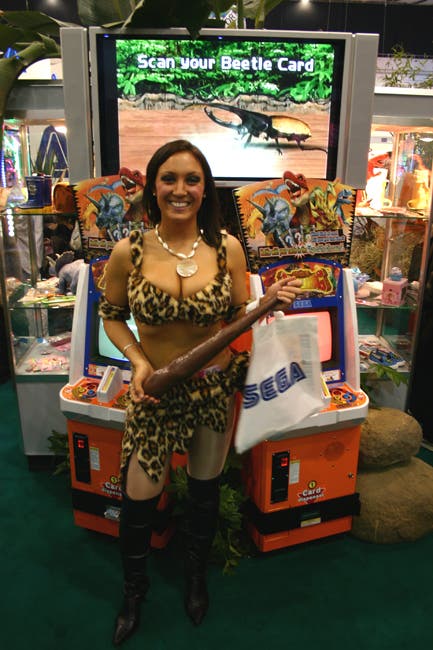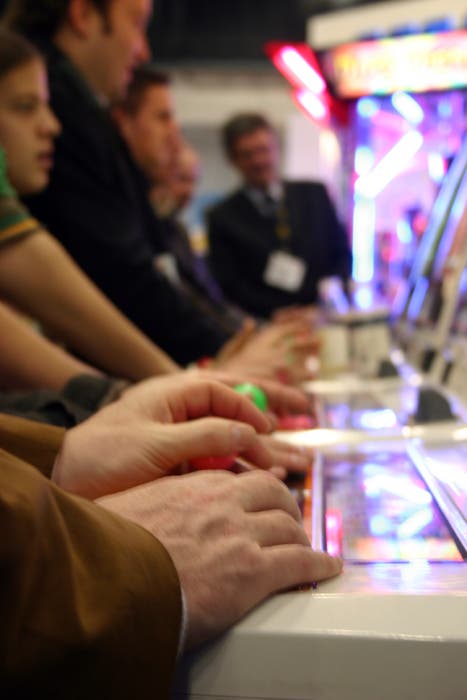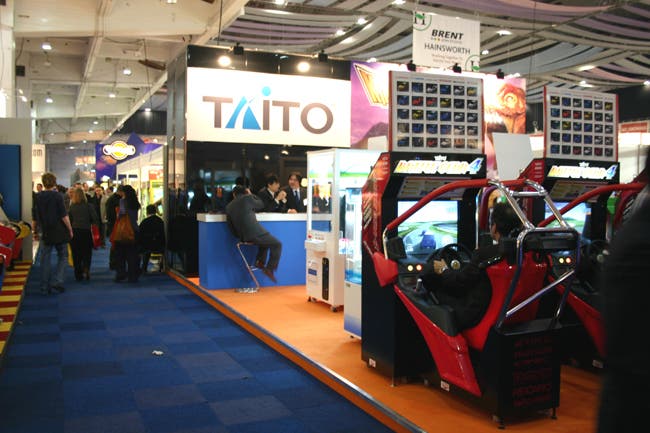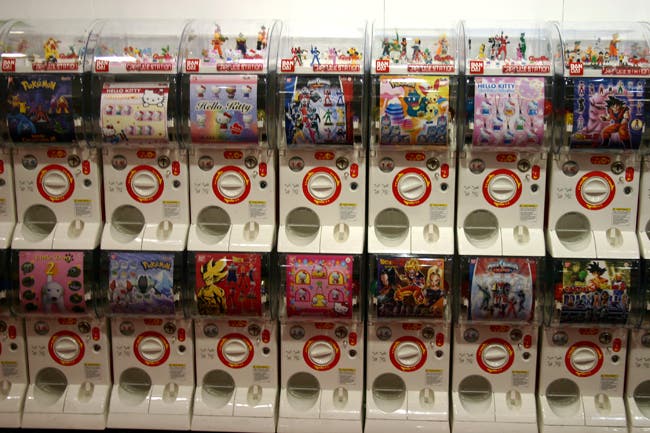The Arcade Fire: ATEI 2006 Report
Consoles commit ongoing patricide.
You know that moment in the action film: the hero is trapped in an ancient (yet curiously meticulously maintained) temple trap, the sweat base-jumping slow motion from his chiselled chin. The walls are closing in, scraping stone on stone as they move in hungry for the crush. Our view circles his face as his eyes dart dilated, desperately, mortally searching for a way out of this scriptwriter’s lazy conundrum.
Normally it’s at this point he bounces up the walls out of the trap, or perhaps the damsel flicks a life-saving shut-off switch. But there is no script, no film and he isn’t an actor. There is no way out. The room slowly, dreadfully leans in for the kiss. The south wall bumps our hero’s back at the same moment that his chest is flattened by the north. He turns his head, even as the air is squeezed irresistibly from his lungs; an effort to hold on to just two more seconds of precious life before his skull snaps and consciousness dribbles useless and crimson to the floor.
Pause.

This is the state of the UK arcade industry; just as it has been for five maybe ten years. Impending doom stubbornly caught in a moment it cannot break free from. Home consoles gingerly cradling the UK videogame industry, backs turned on their aging parent: the arcade scene.
ATEI (Amusement Trades Exhibition International) is videogames’ nursing home annual outing; Sega, Konami, Namco and Taito congregate at London’s Earl’s Court to relive cathode glories now long consigned to cobwebbed corners of filthy fruit machine parlours and salt-stained piers. It’s a trade only event but the arcade kids often manage to sneak in to play the latest titles just before they appear at London Trocadero. We are one of them.
This year was more interesting than most thanks to a range of new arcade boards that have leapfrogged any current console technology weaker than an Xbox 360. In particular Sega’s Lindbergh platform dazzled with Virtua Tennis 3 and House of the Dead 4. The former offers the most realistic looking players and crowd yet seen in a tennis game. It’s a glorious lick of paint to a game that thankfully sticks very closely to its Dreamcast/PS2 forbears. The control scheme is as elegant and understated as ever with its one button for topspin, one backspin and both for a lob, but it is consistently astounding how much depth of technique this allows for. For an extra credit the game issues you with an IC smart card, a kind of paper-thin memory card that can be slipped in your wallet, on which is stored your personal data, game record and your world ranking in the game.

House of the Dead 4, plastered all over 62” DLP screens, looked similarly beautiful, albeit in a flesh-tearing zombie vomit type way rather than strawberries and doubles team. James Taylor, star of the second HOTD game, returns as the protagonist, hoisting along a new slight-framed and silly-voiced beauty as his partner. HOTD 3’s pump action shotguns are now replaced with submachineguns, which require just a quick shake to reload. Graphically the game is stunning but the squint and spray bullet gameplay is less satisfying.
Virtua Striker 4 ver. 2006, Sega’s football game that seems to perennially miss the mark, was a real disappointment. The developers have chosen to update countries, stadiums, kits and data rather than tackling the more serious issue of the gameplay being actually pretty rubbish. Dribbling, passing, shooting and tackling are all extremely clunky and un-enjoyable, something which Pro Evolution Soccer 2006 on Konami’s stand conversely managed to get just right. Currently Japan-only, this arcade machine allows players to take their own dual shock controllers in to the amusements and plug them into the machine as they play real opponents from around the world. The only obvious benefit over, say, doing the same on Xbox live, was the addition of a webcam that allows you to watch who you're playing on a little screen to the side of the cabinet.
2D old-school fans were catered for by SNK’s Metal Slug 6 and King of Fighters style Fist of the North Star both of which were running on Sega Sammy’s Atomiswave hardware. But the real genre of the show was the lightgun game. Alongside Sega’s HOTD4, Konami were showing cartoon-style Cooper’s 9 and the disappointing Lethal Enforcers 3, in which you play as a Japanese police marksman in a variety of felon-hospiltalising scenarios. Namco has the startlingly pretty Time Crisis 4 as their primary plastic-sighted title. Running on System Super 256, a PS3-style rival to Lindbergh’s Xbox 360 magnificence, it was the best of the bunch introducing yet another innovation whereby pointing the gun off-screen shifts the view through a 180-degree view radius.

Driving fans had a number of experiences to keep them keen starting with Sega’s Ford Racing: Full Blown. The early version promises to be the definitive Ford racing game, if ever such a thing were asked for... A range of 25 Ford branded vehicles are available and the developer promises unlockable cross-European features that will be drip fed to players as the months roll on. Taito’s popular Japanese drift style Battle Gear 4 was on show complete with rasping handbrake and memory card ignition key. Sega’s rival anime-themed racer, Initial D, had its third iteration on display (even though it has been out for a year) playing in two huge hydraulic Cycraft cabinets. You strap yourself in and the whole machine tilts violently around as you weave through each course. It’s the best arcade experience in the world and a clear demonstration of how the arcade sector can and should be offering experiences that home console could never dream of providing.
Similarly straying from the usual sit-down stick and buttons cabinet affair was Konami’s latest dance step title: Dancing Stage Supernova. The usual dance heads were all in attendance stepping through each song on hardest difficulty riding a pink flurry of limbs all the way to AAA ranks while Konami’s ‘expert’ booth girls looked on miffed and redundant. Targeted more at the expert player than last year’s Dancing Stage Fusion, this latest European exclusive has over 250 songs, new battle modes and a global tournament system.

The only other completely unique experience on offer was Konami’s To Kyu Okoku Gashaaaan!, roughly translated as Throw Ball Kingdom Smaaaash! Four players take up positions in front of the two huge DLP screens and hurl brightly coloured ball-pool balls to complete various Bishi-bashi style touch-screen challenges. The first level saw you competing against each other to smash the most glass bottles while the final, amazing task requires you all to work together to break up a gigantic meteor before it hits earth and destroys your respective cities, a la Missile Command. It’s outrageously good fun: like a 6-foot multiplayer DS and although your arm stings and aches after just five minutes, you’ll gnash through the pain just to see the credits roll in search of peer-raised glory.
Despite this strong line-up of titles the arcade scene is no nearer to escaping that crushing death at the hands of its offspring, the console scene. But with new hardware and inventive games coming from the likes of Sega (even if they’re primarily being developed with future console conversions in mind), it’s a death that will continue to linger while providing those who can sneak into the show each year with a great day of freeplay arcade machines.

